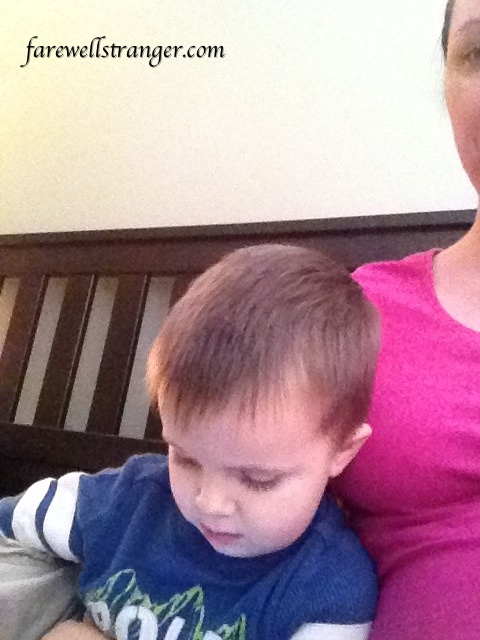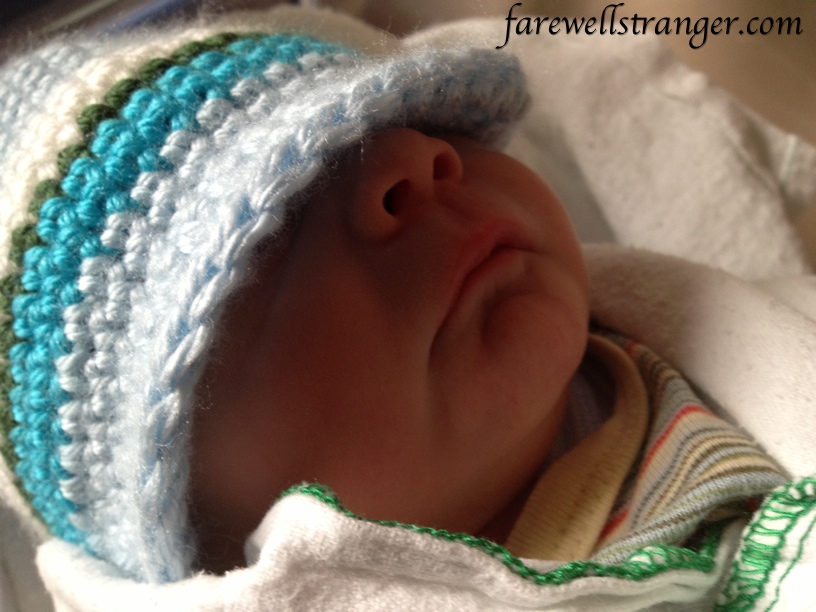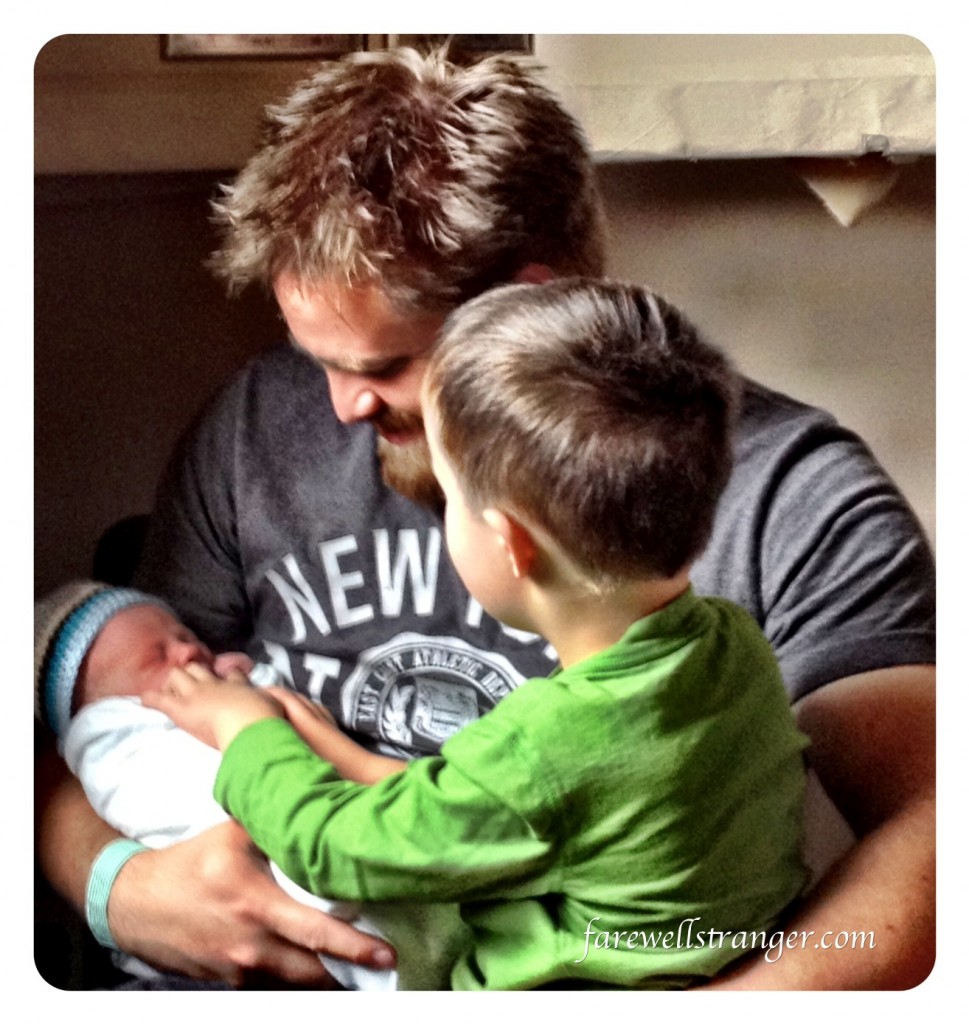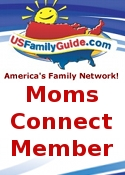I’ve come to the conclusion that I owe my husband a huge thank you. Now that I’m no longer pregnant (and sick) and actually feel like eating, I’ve started cooking again. As I stood poring over recipes the other day I noticed how foreign it felt and realized how little cooking I’ve done over the last year. I knew Rich had kept us going and ensured no one starved (and to be clear, he’s a far better cook than I anyway) but I didn’t realize just how much I had stayed out of the kitchen. [Read more…]
Thoughts on Birth Plans
You probably know that the whole birth experience thing is kind of one of my passions, right? I spent four years being righteously pissed off about ending up with a scheduled C-section with Connor and the whole of this last pregnancy hoping for a different outcome. And I did get the med-free VBAC I was hoping for. (Yay!)
Last night I told Rich I kinda sorta wanted to have another birth just to know what it would be like. He looked at me like I was crazy. I don’t actually want another baby, and the thought of going through all that after-the-fact pain again freaks me right out, but I’m still curious about how it would go.
One thing I totally know — after my experiences and hearing others’ stories — is that you just never know how a birth is going to go. I knew that before I had a baby, and I really, really knew that once my first was born. And so I went into the experience with Ethan’s birth hoping and planning a little bit but trying not to get stuck on one particular outcome. [Read more…]
Ethan’s Birth Story: Part Two
Here’s part one, and here’s Rich’s version of this story.
We got to the hospital (the same one I was born in, incidentally) and we had to park fairly far away from the doors. And I was totally that woman walking through the parking lot, up the stairs, and through the hospital lobby, stopping every few minutes to moan and double over with every contraction. And I was totally that woman who didn’t care.
We went into the delivery room at very end of the hall. It had a long bank of windows all along one side that looked out over the grounds and part of the city beyond. I could see the lights in the nearby beyond shining out into the night, and it felt a little bit like a stage. As though everyone could see into the room in which I would bring a baby into the world, which made me feel simultaneously vulnerable and inspired. But it soon ceased to matter and I forgot all about those windows and whatever and whoever was beyond them.
I got hooked up to a fetal monitor and focused on making it through the contractions. At that point we found out another midwife from our team was at the hospital already with a client who had come in earlier, so she was able to support us as well. We were so incredibly lucky with our team of midwives, and I felt so blessed by the two who were at Ethan’s birth. They kept an eye on him and noticed that his heart rate was going down with every contraction, which they said was due to the cord being compressed. It would go back up, but after a while of this they started to be a bit concerned.
At that point, they brought in an OB who suggested an amnio-infusion (adding fluid back through an intrauterine catheter). They explained that it would help the issue of the cord being compressed and avoid other complications, but it would require transferring care from the midwives to the OB. The whole team (our midwives and the OB, who was a resident, and her supervisor) was very respectful of our feelings about this, but we didn’t hesitate. Do it. Definitely. No question.
That process did help for a while and we continued on. And then his heart rate started going down again and wasn’t coming back up, so the OB decided it was time to make this thing happen. I had been at nine centimetres the last time they checked and she now indicated that it was time to push when I felt the urge. Push with all your might, she said, or they’d have to use the vacuum.
At that point I started to feel like I had no idea what I was doing. How would I know when to push? And how do I do it? How do I get him out fast enough to make sure he’s okay?
My labour wasn’t especially long (unless you count the two straight days of contractions) but it was intense. And I was tired. All I could feel was pain – there was no beauty, no serenity, just pain. And then suddenly I realized what people mean when they say they had the urge to push. Hoo, boy. This baby was coming out NOW, but I still had to do my part.
Because of the deceleration of his heart rate, the OB had me push as long as I could during contractions, and then started asking me to push even when I wasn’t having a contraction. By this point there were all kinds of people in the room – two midwives, two OBs, an OB’s assistant of some sort, a nurse or two and a team from the NICU, who were there to check him out after he was born. And Rich of course.
Thank God for Rich. He had talked me through every contraction, using imagery and counting down and telling me when each one was just about over. I know he had been worried about whether he’d be good at supporting me during labour, but I never was. I knew he’d be fine. And he was – better than fine. Amazing, in fact.
Having everyone in that room telling me to push quickly became overwhelming, so I finally looked at him and asked him to tell me what to do. I blocked out every other voice in that room and just listened to him. And when it felt like it should be over I asked him to tell me what was happening.
“I can see his head! His head is coming out!”
It was the most intense moment of our relationship.
It really felt like it should be over by that point. It certainly felt like I’d pushed enough to get a whole baby out, but apparently not. It’s an odd sensation to have a baby coming out of you and to feel as though you don’t have it in you to push past the head.
“I can’t do it.”
“GET HIM OUT!”
It wasn’t my finest moment.
They told me to reach down and feel his head, so I did. It was small and slimy and it belonged to the baby I had waited so long to meet. I had no idea who he was, but I was ready to find out.
I pushed with absolutely everything I had in me, admittedly mostly motivated by the desire to have this over with. And just as I was convinced I wasn’t going to be able to do it, he was out.
We delayed cutting the cord for a bit and the OB was awesome then too, suggesting that he’d be best with me. So they put him on my chest and there he was. My baby. The one I had waited for. We had done it together.
We had a cuddle and Rich cut the cord, but Ethan didn’t cry when he was born. The NICU team took him to have a look, and he still didn’t cry – never did, actually, but he was okay. I remember looking over at him and thinking he looked like Connor (though later I decided he didn’t). I noticed his hair – blondish red and wavy. I noticed how little he was.
By that time the OB was trying to deliver the placenta, and that’s where things got really interesting. She had part of it in her hand and realized it hadn’t all come out. Apparently I have a heart-shaped uterus (which apparently likely explains why Connor was so stubbornly breech) and some of the placenta was stuck. The OB was going to reach in with her hand and try to remove it, so my midwife offered me gas. “This is going to hurt,” she said. I almost laughed – I had just given birth without pain relief, and delivering the placenta was going to hurt?
I should have asked for something stronger. Like a frying pan to the side of the head.
There are really no words to explain how painful that was. I held the mask to my face until I felt loopy from the gas and thought I might pass out, at which point I removed it and resorted to good old fashioned screaming. It was a stubborn placenta and I vaguely remember the OB telling me she needed to try again. And then, “I’m sorry – just one more time.”
I couldn’t even process what was going on, and when she was done I noticed that the OB had blood all the way up to her elbow. In my post-pain, loopy state I couldn’t figure out why. It was (of course) from her attempts at making me placenta-free, which, I found out later, took four tries. No wonder it bloody hurt.
After that, things were mostly normal. I got stitched up (oh wait, there were some issues there too, but you don’t really need to read about that, I’m sure) and we visited with Ethan. My midwife brought me toast and apple juice and I wanted to marry her.
It was at that point that we finally weighed him. I knew he was little, but I didn’t expect him to be 5-lbs-6-oz little. I nursed him and he was a champ just like his brother. He still hadn’t cried.
We were in the delivery room with our midwives until about 4 a.m., at which point we got moved to a postpartum room because I needed antibiotics after the uterus-scraping incident. But that time in that room will forever stay with me – looking out the windows, which I noticed again, talking with the team of people who helped me do the most profound thing I’ve ever done, and taking a bath with the newest love of my life.
As we made our way down the hallway towards the postpartum unit, we passed the nurses’ desk and some people in the hallway.
“Do you see?” I wanted to ask. “Do you see what I did? I made this and he’s tiny and beautiful and perfect.”
I did it.
We did it.
He’s here.
Ethan’s Birth Story: Part One
I don’t know how to write this. I’ve started it over and over in my head but I’m not sure if any of those words are right. I think maybe I just need to let it come out the way it wants to.
If you’re more a fan of short versions of birth stories, here it is:
I had a VBAC. Unmedicated. My water broke at 3 p.m., we went to the hospital at 8:30 and Ethan was born at 11:39 p.m. after about 20 minutes of pushing. That part, and what happened after, hurt a lot. The apple juice and peanut butter toast my midwife brought me afterwards was the best thing I’ve ever eaten. And it’s a good thing this is our last child because I never want to do that again.
That version sums up many of the major, relevant details but of course it misses the nuances. It avoids what makes this a story.
The story really started just over four years ago when Connor was born via a scheduled C-section because he was breech. But don’t worry – this isn’t a story that takes four years to tell. It takes a couple of weeks, though, starting when I left work and started my maternity leave four weeks before my due date. At the time I worried that I was copping out, especially because I hadn’t even been at my job for a year, but I needed to stop working. Nine months of nausea and heartburn and just general I-hate-being-pregnant was enough and I needed a break before trying to cope with a new baby. And I wanted to have some time with Connor before he got plopped into the role of big brother. But I also suspected deep down that leaving early might be a good idea.
And it was. I started having contractions nine days before Ethan was actually born (which was nine days after I stopped working). Small ones, at first, of the Braxton-Hicks variety. I ignored them. Other than being annoying, I wasn’t at first convinced they were leading up to anything. It was self-preservation, I think. When you’ve waited four years for a VBAC you don’t want to let yourself start to hope.
But they kept coming, and the day before Ethan was born I did two things: I googled “how to stop Braxton Hicks” and I wrote a post about how I didn’t really think I was in labour. Because I really didn’t think it was going to happen anytime soon.
I had two nights of no sleep thanks to the annoying (and increasingly regular) contractions and by the morning of October 2 I was tired. We phoned my mom and told her it was probably a good idea for her to come out, thinking only that she could help entertain Connor for a few days. She booked a flight that would get her in at 8:30 that evening.
In an effort to figure out, one way or another, whether the contractions were leading up to anything, we went for a walk in the morning and I plunked myself into a bath in the afternoon.
I was hoping the walk would spur some activity and figured that if the bath didn’t stop the contractions it might at least make me feel better.
And then I had a nap.
I woke up just before 3 p.m. and rolled over and gush, my water broke. Well, what do you know? I thought. We’re going somewhere with this after all.
I texted Rich, who was in the basement playing with Connor. He made it up two flights of stairs awfully fast (excited? nervous? yes!) and we started figuring out a plan.
That plan involved getting my sister to come over to get Connor and calling the midwife, who confirmed that we should let her know when contractions were about four minutes apart. My sister arrived and I retreated up to our bedroom to ride out the contractions while Rich took our dog over to his mom’s.
It was at that point that I realized that this wasn’t going to be a fun ride. Without Rich there I had to get through contractions on my own. For some reason that I can no longer recall (snacks for the hospital, I guess) he was stopping at the grocery store on his way back, so when he texted to ask if there was anything else we needed all I said was, “No, just be quick.”
My sister took Connor to her house where my mom was going to stay (with Connor) when she arrived, and Rich and I kept on with the strategy we used for the next six hours or so.
I’d had all kinds of grand ideas about what I was going to do while in labour – shower, listen to music, use hypnobirthing strategies. But when the time came, I left all that aside and just rode it out. That was all I could do. I just gripped Rich’s hands – wrists crossed, right hand to right, left to left – and tried to remember to breathe.
By about 7:30 my contractions were regularly about four minutes apart, so we called the midwife again. She came over and checked me, determining that I was at about 3 or 4 cm. Which seemed like pretty good progress, though I’d been hoping she’d say it was time to go to the hospital and let this baby slide easily and naturally into the world. (Wishful thinking.) But it wasn’t, so I laboured on.
But only for another hour. At 8:30 I told Rich to call her back; she came and, having reached 6 cm we got the green light to leave for the hospital.
And then it started to snow.
I remember very little of my time labouring at home. Snippets here and there – waiting for Rich to come home, listening to Connor with my sister downstairs, bleeding on our duvet. (Hey, I never claimed this would be gore-free. Consider yourself properly warned before reading further.) Otherwise all the contractions just blend together in a vision of pain and clasped hands. But I remember the drive to the hospital, uncomfortable as it was, as a journey soaked in anticipation and decorated with snowflakes bathed in light.
Part two coming tomorrow.
VBAC: A Dad’s Perspective
In talking about Ethan’s birth after the fact, Rich and I realized we had different perspectives on it. Specifically, he remembered things I didn’t, so I asked him to write his version. I’m tempted to add editorial notes in a couple of places (mostly to defend myself!) but have resisted. I hope you enjoy it.
Robin tried to convince me that it was just false labour. That she’d been experiencing Braxton Hicks contractions for a day and a half and, aside from being tired from losing sleep, everything was normal. “Are you sure?” I asked. “Because I don’t remember seeing a grimace on your face yesterday and I’m positive I would have remembered that.”
Then her water broke.
Earlier in the day (yes, I’d left the birth partner books to the last minute) I’d read that encouraging a woman in labour to relax her jaw would also help her relax the rest of her body and make the contractions less painful. So, during a particularly hard contraction I told Robin to do just that. Please read that sentence again. I told her. Not asked. Not suggested. Told. That was my first mistake.
Now, you should know that my wife is a very independent person and has been from a young age. Her mother likes to share the story of Robin’s first sentence as evidence of her independence: “Do it self, mom!” So, you can imagine that, during the difficulties of labour, being told to do something, anything, wasn’t welcome advice. Robin’s reaction was to do the opposite, which made the contraction more painful, which made her declare, “I can’t do this anymore.”
I didn’t think much of that statement at the time but it resonates with me now. Not only could she do this but she would endure so much more before the end of the night.
During a previous visit, our midwife had shared the story of a couple who’d used guided imagery to manage contractions—a leaf rising and falling over a wave of water. It sounded corny to me at the time but it ended up being a lifeline of relief during labour. During every contraction I would describe this leaf climbing up and falling down a wave on a river. And having that leaf to follow really did seem to make the pain more manageable for Robin. So that’s what we did, every contraction – just ride with that leaf.
When it was time to go to the hospital I packed our bag in the car, got Robin settled in the passenger seat and opened the garage door. To my horror I saw that the first snowfall of the season was here. Crap!
I pulled out of the garage and slowly started driving. Every few minutes Robin would grab my hand and say, through gritted teeth, “Do the leaf. Do the leaf.”
So there we were. Wife in labour. Driving to the hospital. In the dark. Snow piling up. Visibility diminishing. People driving like it was the first snowfall of the year. And I kept thinking to myself, “Please don’t crash. I don’t want my son born in a ditch,” all the while trying to describe a leaf on a river.
Our midwife arrived at the hospital before us. (Apparently it’s quicker to get around if you’re not doubled over in pain every four minutes. Who knew?) Robin was dressed in a fetal heart rate monitor and a band to measure contractions—precautionary side-effects of her previous C-section. That’s when we discovered something was wrong. During each contraction, the baby’s heart rate dropped. His umbilical cord was being compressed and he was in danger of oxygen deprivation.
The obstetrician on duty was called in and a catheter was inserted into Robin’s uterus so fluid could be pumped in to provide cushioning for the cord during contractions. If that didn’t work Robin would require an emergency C-section.
C-section. It’s a four-letter word in our house and it’s something I’d been dreading. Not on my account but for Robin.
Personally, I would have welcomed another C-section. My fear leading up to the births of both my sons, was that I wouldn’t be an good birth partner. That I would fail to support Robin in the way she needed. That the words I’d choose would make the experience worse or that I wouldn’t be able to physically endure a long labour. (“Sorry honey, you keep going. I’m exhausted.”) The C-section that brought Connor into this world spared me from realizing that fear. If I never had to find out how I’d do as a birth partner, that was fine with me. Bring on the C-section.
But for Robin, having a C-section for Connor’s birth was a robbery. My wish for her, for this delivery, was that she be given the chance to give birth on her terms. That she be able to test herself, if that’s what she needed. To fight on behalf of her helpless son and shepherd him into this world. To prove to something deep inside that she had what it took to be the mother she needed to be.
The additional fluid worked, the baby’s heart rate stayed up, and Robin continued to labour.
During most of her labour Robin was on her feet, walking around the room. During contractions she gripped my hands and rested her forehead on my chest. Towards the end she would growl and implore this baby to come out.
Then came the overwhelming need to push.
Gathered in the room were at least ten people: Robin, two midwives, the obstetrician, her resident, a nurse, three members of the NICU, and me. The additional fluid had leaked out and the umbilical cord was again being compressed. If this baby wasn’t delivered right away then the obstetrician had no choice but to use a vacuum to pull him out—something we wanted to avoid.
During the next contraction Robin was to resist as long as she could and then push with all her might—even after the contraction ended. The problem was that five people were trying to explain the plan to her at once.
She looked over at me with a mix of confusion and exhaustion and said, “Tell me what to do.”
We waited. Then she pushed with everything she had. When she could no longer hold her legs up, our midwife and I held them for her. She pushed like she’d already given birth to three kids. I could see the baby’s head. She growled. She pushed again and in a sublime moment, his head came out. One more push and out followed the rest of his body.
Immediately I felt an overwhelming sense of joy, pride and relief. Joy in the fact that he was here and healthy. Pride in Robin and what she’d accomplished. Relief that it was all done.
Only it wasn’t all done. There was a problem. The placenta hadn’t released from the uterus and the obstetrician would have to remove it manually.
Our midwife offered Robin laughing gas and I held her hand as she screamed and screamed while the obstetrician, as carefully as she could, reached her arm inside and scraped away pieces of placenta. “Just one more time.” “I’m so sorry. Just one more time.” FOUR times.
Midwives experience a lot of deliveries. After everything was done and Robin cradled her baby to her chest, Wendy, a seasoned midwife, turned to me and said something that I’ll never forget. She’d not met many people who were able to endure what Robin just had—“She’s one tough lady.”
And I agree.
Looking for my version of this story? Start here with part one.

















